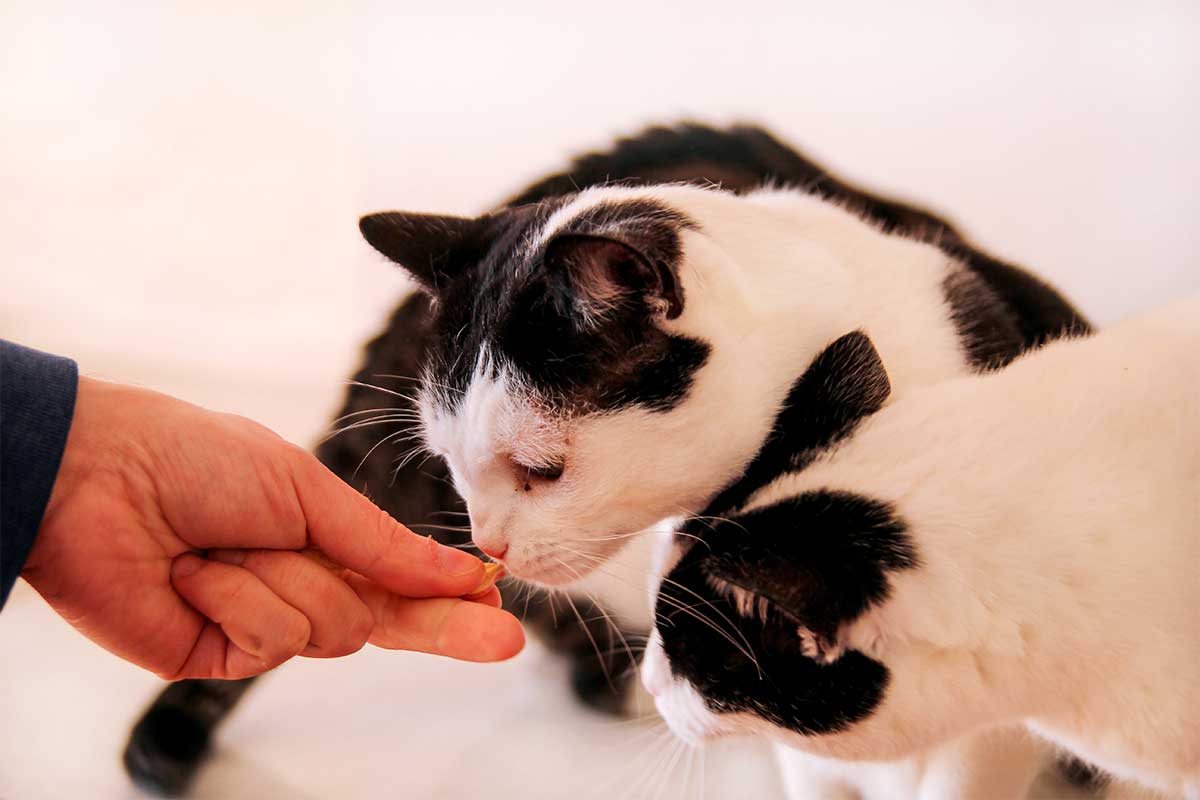Creating a Fear Free environment for your cat at the veterinary clinic, groomer’s salon, or even at home begins with finding the right motivator (or two or three). Where one cat might cooperate with many indignities if she can have some chicken baby food, another will ignore the noise of a groomer’s salon if she has a feather.
What Is A Motivator?
Animal trainers call an item that can garner an animal’s cooperation a motivator. With the right motivation, a busy kitten can remain in one place for brushing or a cat will allow blood to be drawn. While focused on this special thing that gives the animal pleasure or comfort, other things can be ignored.
Motivators can be a lure for your cat to follow, encouraging her to assume a position or move to a specific place. A motivator can also be distraction from a frightening situation. Last, and perhaps most important, the motivator is useful as a reward.
Food Is Often The First Choice
For an animal, food is survival, tastes good, and brings pleasure, so it is an effective motivators for many cats. The best food motivators are easily eaten. Think chicken or turkey baby food in jars, canned cat food, or bits of meat. When purchasing meat based baby food, just make sure they are free of onions in the ingredients. Onion can be toxic to cats.
The food should smell good—at least to a cat. The odor of a special food can help to garner a cat’s attention in stressful situations. Tuna fish or canned salmon work well for many cats as do tiny bits of Swiss cheese.
Think outside the box for picky or stressed cats. Cheese from a can with a nozzle is great and is easy to present to the cat. Just spray a bit on a plastic spoon, pretzel stick, or on the floor. Avoid your fingers because some cats will accidentally grab your finger along with the cheese. Ouch! Cream cheese and whipped cream are also wonderful. Another food that works but is messier to give to the cat is chicken or beef broth. Suck up the broth with a syringe and let the cat lick it from the tip of the syringe.
Think About Toys
While food is usually the most effective motivator, some cats won’t focus on food when stressed or distracted. Having a backup motivator is always a good idea.
Toys that you know your cat likes should be tried first. These might include crinkly items, objects with bells, feathers, or tiny stuffed toys with squeakers. A crumpled paper bag (or piece of paper) could work, as could a cardboard box.
Flirt (or fishing) pole type toys usually don’t work for the veterinarian’s clinic or grooming salon as they are active toys. The cat can’t be examined, treated, or brushed if dashing after the toy. However, active toys can help the cat become comfortable with the environment or during breaks. Depending how your cat reacts to catnip toys, they may or may not be recommended, as the cat’s physical signs, behavior, and even reactions could change under the influence.
Comfort Items From Home
Nervous or stressed cats who ignore food and toys may react positively toward comfort items from home. These could provide security and allow the stressed cat to relax, at least a little.
Your cat’s bed from home or a familiar fleece blanket often works best. Allowing them to snuggle down and hide helps many cats feel better about their situation.
Even better, though, is something of yours. Your bathrobe, t-shirt, or even a dirty sock tucked into your cat’s bed could work magic.
You Know Your Cat
You know your cat best, so think about what gives your cat pleasure, joy, and comfort. Choose two or three of these things, then, and use them at home when you need to care for your cat. Bring them with you to the veterinary clinic or grooming salon and explain how they can be used to help your cat. If you patronize a Fear Free facility, of course, the veterinary team will be thrilled to have your support and guidance regarding your cat’s favorite motivators!
This article was reviewed/edited by board-certified veterinary behaviorist Dr. Kenneth Martin and/or veterinary technician specialist in behavior Debbie Martin, LVT








